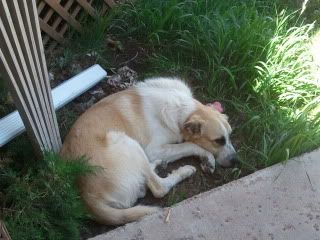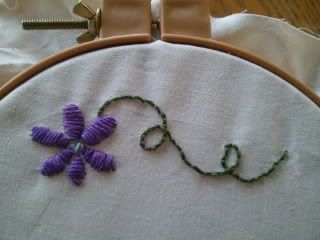
From the beginning of The Turkey Project, I was worried about how Two Little Girls were going to respond. I prepared myself for dramatic tears and declarations of vegetarianism. I assumed it would be ugly. After all, they are both old enough to remember five months ago, when those little baby turkeys were adorable, fluffy, inquisitive little creatures that they could hold in their hands and nuzzle softly.
I was worried for nothing. When the time came to butcher our birds, the girls were excited as all get out. Not that we weren't all a bit sad, too, but they were just so interested in the whole process that it far outweighed the sadness, and the prospect of good turkey meat for many dinners to come helped, too.
I vetoed having them in the barn during the actual killing. When they tried to spy through a crack in the door, I shooed them away. It wasn't that they were thrilled with the idea of murdering a turkey, it was simply that the whole idea of how it would happen was fascinating to them.
As soon as the bird was dispatched, and we carried it into the shop to process it, the girls were in there with us. As The Daddy pulled the guts out, the comments and questions came pouring out. They saw firsthand the trachea, the gullet (which we cut open to show them the food still inside), the heart and liver. Not only did they see them all, but they touched them. Hands clad in rubber gloves, they loved touching the different parts. They noted that the gullet was surprisingly hard, that the lungs were particularly bloody and fragile, and that everything was still very warm. They held the feet and examined them (before giving them to the dogs), got to see what hollow bones look like, and were able to see up close how a ball and socket joint works.

There was also much talk about exactly how we were going to cook him, and how good he would taste.
Are they scarred for life? Absolutely not. They're not even refusing to eat meat. In fact, I think they are far better off on many levels for having been a part of this experience.
Most of us, throughout middle and high school, dissected a number of different animals. I remember crawdads, frogs, and even a cat. I also remember being thoroughly disgusted with the entire project, but there was one reason for that: we were made to think it was a disgusting activity. The kids in the upper grades talked about how awful it was. The teachers even told us that it was coming with a hint of dismay. It was assumed we would all be grossed out, and so we were (or at least, the girls were.) It was simply expected.

You see, I think it's all about the approach. We never hinted to the girls that this would be a 'gross' or 'disgusting' endeavor. It simply 'was'. We never required or forced them to have any part of it. If they didn't want to eat turkey this fall, I wouldn't make them. But, being already quite homeschool-minded, they viewed the whole process as educational. They asked a million questions, and we did our best to answer them. When we didn't know, we tried to figure out the answer together. They were indubitably thrilled when we finally got around to cutting open the gizzard, so that they could see the rocks which the turkey had swallowed in order to digest his food.
The much anticipated Opening of the Gizzard -
note the rocks inside.
The other reason that I really feel like this was a healthy experience is that I know for certain that my daughters will forever appreciate every piece of meat that is set in front of them at the dinner table. For five months, they fed and watered the turkeys each day. They lifted Turkey Boy into the coop at night when he could no longer get in alone, and eventually built him a bridge to make his life easier and more comfortable. They treated all three with great respect, if not necessarily love, until the ends of their lives. Having walked this journey, they now have no doubt exactly what is involved in putting food on the table in front of them, and they will forever have a deeper appreciation for it.
There are few cultures like ours, where children are so far removed from their food that some don't even realize that "chicken" actually comes from a dead chicken, and that "turkey" is actually just that - a turkey. On so many levels, I really think that is sad.
So no, I don't think my girls are scarred. I think they are far better off for this experience. I doubt they will ever be quite as fascinated as they were this year, and I'm not sure I could ever require them to help with the processing of meat (unless it is an animal they hunt and shoot themselves.) But I think over the course of several years of this, they will have the skills necessary to accomplish it if needed, and they will always appreciate, maybe a bit more than other people, the food that is set before them.
===
Miscellaneous thoughts on the subject:
*When you bring the birds home, DO NOT NAME THEM! Not even "Thanksgiving" and "Christmas" or "Thigh" and "Breast". Call them turkeys. Names bring forth perceived personalities, and personalities make them friends.
*Begin referring to them as "food" immediately. Discuss what will happen, preferably before they take up residence in your brooder. Address concerns, sadness and uncertainties frankly and honestly, but compassionately.
*Provide pets. When The Oldest was upset at the thought of her sweet white poult eventually being eaten, we agreed to adopt a new batch of laying hens. This gave her something new to love and invest her emotions in. Adding a couple of little banty hens to the flock was not an expensive or difficult thing to do, and it, eh, smoothed ruffled feathers quite well.
*Do let your kids help care for the poultry. They should know, firsthand, how much work goes into raising birds, whether it be for eating or for laying. This is where the appreciation factor comes in.
*Don't force them to take part in anything that makes them uncomfortable. If you intend to raise meat birds year after year, there is a good chance they will eventually be comfortable with the whole deal and will learn the process. Some kids can handle this all right away, others can't. Don't push them.
*If you can, start them young. Littlest One has seen animals butchered since she was two years old. It doesn't even register as anything disgusting to her, it's simply how her meat is prepared. And she does like her steaks. Blood, bones, raw meat, even a severed head - none of that stuff fazes her because she's grown up with it.
*Use it as a learning experience. There is no greater way to learn than hands-on; even public schools will admit that. If they want to touch, let them. If they want to help, encourage it (even if it makes the process take hours longer than it would otherwise.) If they would rather just watch, allow it, and always answer questions as well as you can.
*Go into it without prior expectations. Don't assume that they will feel any certain way. Kids, as a general rule, want to live up to their parents' expectations. If you have no expectations, they will be free to react as they will. When they do, be compassionate, and be honest.
*Do discuss the importance of respecting the turkey's life, and that his life was taken to sustain theirs.
Obviously, I'm no expert. These are just things I learned over the past months, raising and butchering our own meat alongside my children. I'm sure there will be folks who disagree with me, and I would be thrilled to hear any other suggestions folks with more experience have to offer.
===
This post is linked up at The Prairie Homestead's Weekly Barn Hop. If you have any homestead-related posts to share, be sure to link up as well!




































